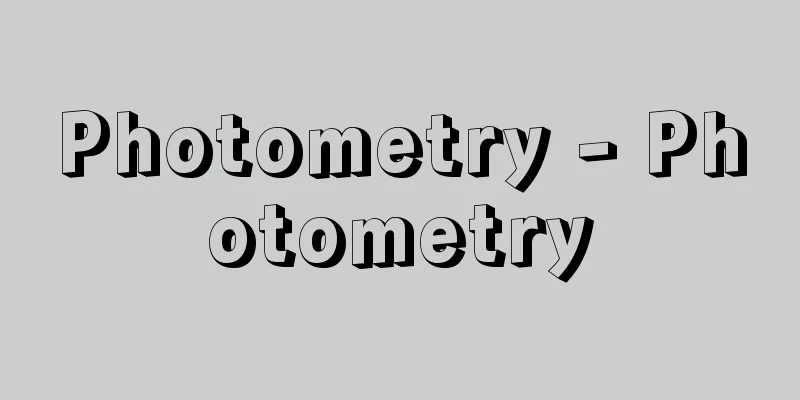Photometry - Photometry

|
It refers to measuring the amount of light. Quantities of light include luminous intensity, luminous flux, illuminance, luminance, and luminous emittance, which are called photometric quantities. Photometric quantities are evaluated by the standard relative luminous efficiency, which is standardized by investigating the relationship between human perception of light and darkness and wavelength, so the response characteristics of the light receiver that measures photometric quantities with respect to wavelength must be very close to the standard relative luminous efficiency. Also, since the brightness perceived by the eye is related to the amount of light at each moment, photometric quantities are based on the amount per unit time. Measuring light with the naked eye is called visual photometry, while measuring light with a physical light receiver such as a photocell or phototube is called physical photometry, although physical photometry is the more common today. In the measurement of luminous intensity and luminous flux, a standard bulb made of a high-quality incandescent tungsten bulb is used to value the quantity. For example, when measuring the luminous flux of a certain light source, it is valued by comparing it with the luminous flux value of a luminous flux standard bulb using a spherical photometer. Also, luminous intensity is valued by the luminous intensity value of a luminous intensity standard bulb. Illuminance, luminance, and luminous emittance are measured using an illuminometer, luminance meter, and luminous emittance meter, respectively. The process of rating or checking that these instruments show the correct values is called calibration, and for this, a luminous intensity standard bulb (distribution temperature 2856K) with known luminous intensity is generally used. [Takahashi Sadao] "Light Measurement Manual" edited by the Illuminating Engineering Institute of Japan (1990, Nippon Riko Publishing Co., Ltd.) [Reference item] | |Source: Shogakukan Encyclopedia Nipponica About Encyclopedia Nipponica Information | Legend |
|
光の量を測定することをいう。光の量として、光度、光束、照度、輝度、光束発散度があり、これらは測光量と称される。測光量は、人の明暗の知覚と波長の関係を調べて標準化した標準比視感度によって評価されるため、測光量を測定する受光器の波長に対する応答特性は、標準比視感度にきわめて近似していなければならない。また、目で感じる明るさは瞬間ごとの光の量に関係するので、測光量は単位時間当りの量をもとにする。肉眼により測光することを視感測光、光電池や光電管等の物理受光器で行うことを物理測光というが、現在では物理測光が主である。 光度、光束の測定では、量の値づけのために高品質の白熱タングステン電球でできた標準電球が用いられる。たとえば、ある光源の光束を測定する場合、球形光束計を用いて光束標準電球の光束値と比較して値づけられる。また、光度の場合は、光度標準電球の光度値により値づけられる。照度、輝度、光束発散度は、それぞれ照度計、輝度計、光束発散度計により測定される。これらの計器が正しい値を示すように値づける、あるいは確認することを校正というが、これには光度既知の光度標準電球(分布温度2856K)が原則的に使用される。 [高橋貞雄] 『照明学会編『光の計測マニュアル』(1990・日本理工出版会)』 [参照項目] | |出典 小学館 日本大百科全書(ニッポニカ)日本大百科全書(ニッポニカ)について 情報 | 凡例 |
<<: Sozzini, Fausto (Paolo); Socinus, Faustus
Recommend
Azad
Indian politician and scholar. Born in Mecca, Arab...
Tsukubane-sou - Tsukubane-sou
A perennial plant of the Liliaceae family (APG cl...
Hatanosho
The largest manor in Tosa, covering almost the ent...
Kelly, PK
…It can also be translated as “Green People.” The...
Sieve tube
Also written as sieve tube. A tubular cell or tiss...
precocial
…In the latter case, the eggs are smaller, making...
Pyatigorsk (English spelling)
A city in the Stavropol region of the North Caucas...
nevus sebaceus (English spelling) nevussebaceus
...There are usually no symptoms, but some people...
cordillera
…Mountains are usually grouped together and occup...
Byzantium
...Population: 7,616,000 (1994). In ancient Greec...
Novaruputa
…It is a Quaternary stratovolcano composed mainly...
Portunus sanguinolentus (English spelling) Portunussanguinolentus
… [Takeda Masatomo]. … *Some of the terminology t...
Morotai Island (English name) Pulau Morotai
An island in the northern part of the Maluku Islan...
Puerto Cabello (English spelling)
A port city in the state of Carabobo in northern V...
Orostachys
...They have succulent leaves, but lack stipules,...









